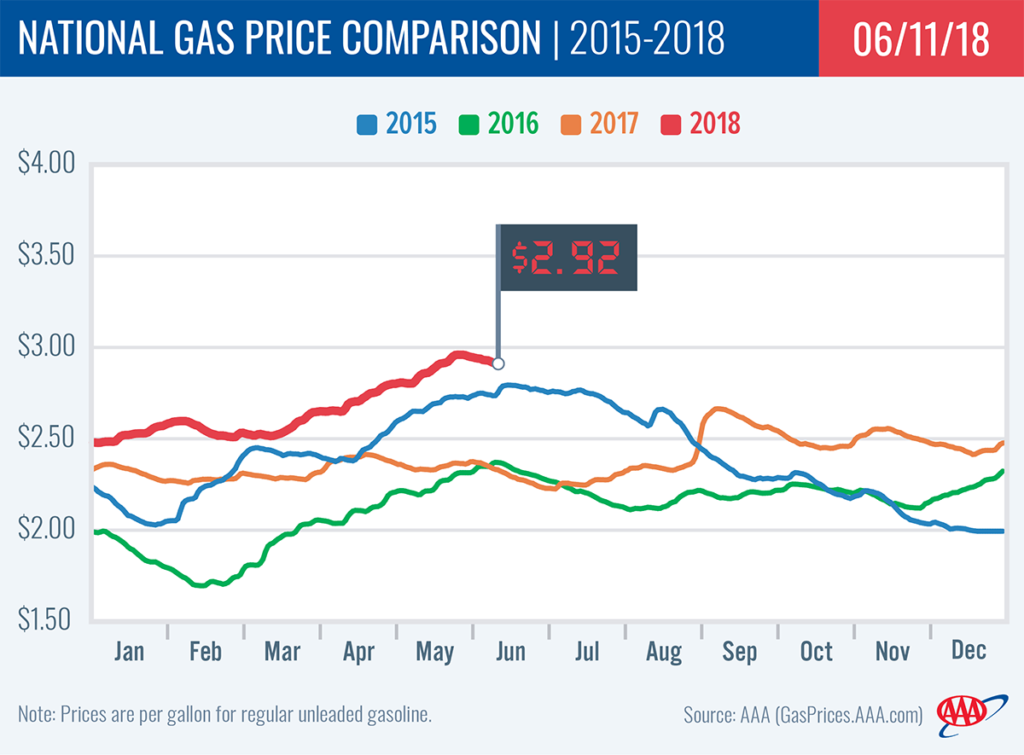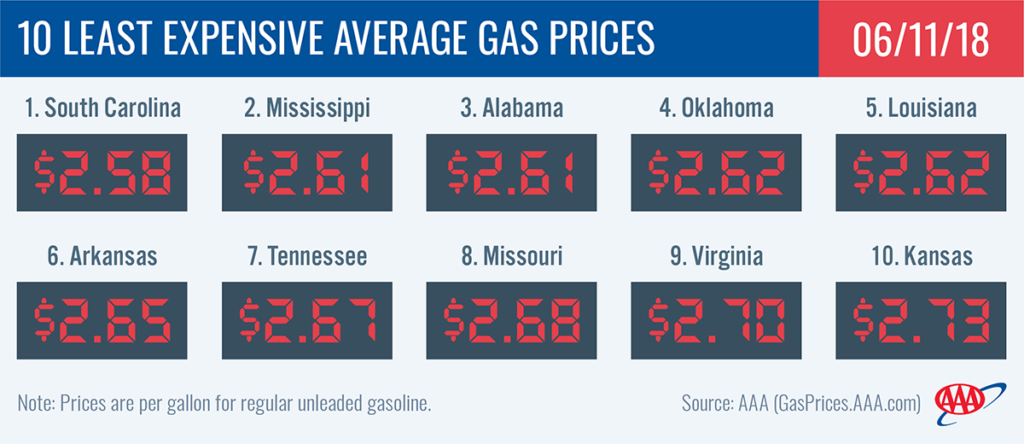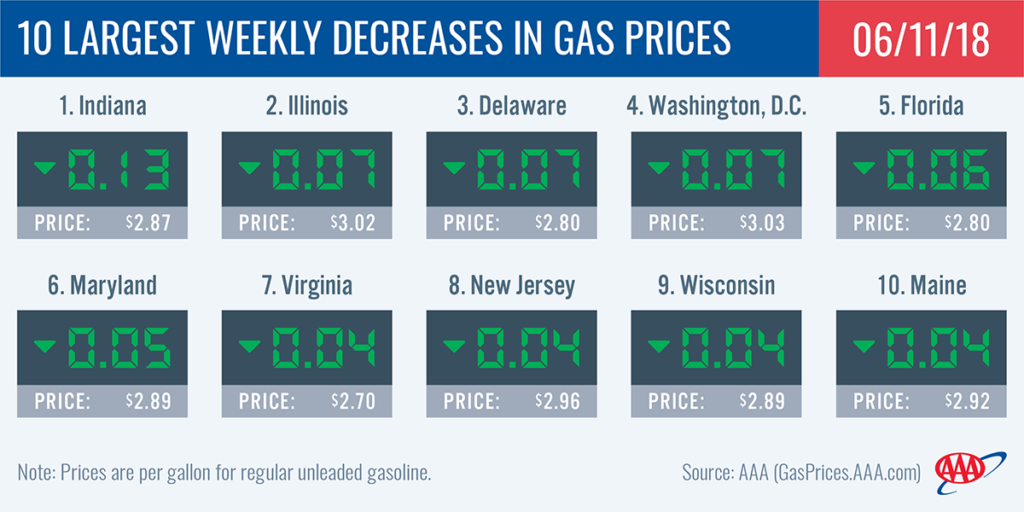At $2.92, the national gas price average has dropped four cents since the beginning of June. Today’s average is three cents less than a week ago, six cents more than a month ago and 58 cents more expensive than a year ago. On the week, only eight states saw prices increase while all others dropped by as much as 13 cents or remained stable.
“Gas prices continue to dip across the country, but remain nearly 50-cents more expensive than last summer in every state,” said Jeanette Casselano, AAA gas price expert. “The higher prices seem to be influencing driving habits. While consumer gasoline demand remains strong, it is slowing and not growing.”
Dropping by 713,000 b/d, the Energy Information Administration (EIA) reports that demand registers – for the first time since mid-January – just under 9 million b/d. This is surprising, as levels have consistently measured above the 9 million mark every week in June since 2015.
Quick Stats
- The nation’s top 10 least expensive markets are: South Carolina ($2.58), Mississippi ($2.61), Alabama ($2.61), Oklahoma ($2.62), Louisiana ($2.62), Arkansas ($2.65), Tennessee ($2.67), Missouri ($2.68), Virginia ($2.70) and Kansas ($2.73).
- The nation’s top 10 largest weekly decreases are: Indiana (-13 cents), Illinois (-7 cents), Delaware (-7 cents), District of Columbia (-7 cents), Florida (-6 cents), Maryland (-5 cents), Virginia (-4 cents), New Jersey (-4 cents), Wisconsin (-4 cents) and Maine (-4 cents).
West Coast
Pump prices in the West Coast region are among the highest in the country, all topping out above $3.00 per gallon: California ($3.72); Hawaii ($3.71); Washington ($3.46); Alaska ($3.43); Oregon (3.34); Nevada ($3.33); and Arizona ($3.07). On the week, prices continue to mostly decline in the region by a penny or two. However, Arizona (+1 cent) and Alaska (+2 cents) saw increases, while Oregon (-2 cents) saw the largest decrease in the region.
According to EIA data for the week ending on June 1, inventories of gasoline fell by 200,000 bbl to reach 31.1 million bbl. When compared to a year ago, levels are still up more than 3 million bbl and could contribute to price stabilization in coming weeks.
Great Lakes and Central
The majority of states in the Great Lakes and Central region are seeing cheaper gas prices on the week. Indiana (-13 cents) saw the only double-digit drop in the country, which brings the state’s gas price average ($2.87) well under the $3 mark it was at last Monday. Other notable week-over-week pump price decreases in the region: Illinois (-7 cents), Wisconsin (-4 cents) and Iowa (-4 cents). However, not every state is seeing this trend. Four states saw prices jump including Kansas (+2 cents), Ohio (+2 cents), Michigan (+2 cents) and South Dakota (+1 cent). With the weekly increase, Michigan’s gas price average is at the $3 mark, making the state’s average the second most expensive in the region behind Illinois ($3.02).
Inventory levels continue to hold slightly above the 52 million bbl mark. According to the latest data released by the EIA, this is the lowest inventory levels of the year for the region and about 2.6 million bbl below levels at this time last year.
South and Southeast
Gas prices are getting cheaper, slowly, but surely in the South and Southeast. With this week’s drops, Florida has seen an 11-cent decrease since Memorial Day. On the week, gas prices in the region are six to one cent cheaper in every state.
The country’s cheapest gas price averages can be found in the region with these states claiming the top six least expensive spots: South Carolina ($2.58), Mississippi ($2.61), Alabama ($2.61), Oklahoma ($2.62), Louisiana ($2.62) and Arkansas ($2.65).
Gasoline inventories bumped up to 82 million bbl following this week’s 3 million bbl add, according to EIA’s latest report. This is the highest build for any region on the week and puts a 12 million bbl difference between the South and Southeast and the Mid-Atlantic and Northeast, the region with the second highest inventory in the country. If inventories continue to increase sustainably, motorists could see some, but not major, relief at the pump.
Mid-Atlantic and Northeast
With a seven-cent decrease, Delaware and Washington, D.C. have the largest drop in gas prices of all states in the region on the week. This lands Delaware and Washington, D.C. on the top 10 list of largest weekly changes in the country along with four other Mid-Atlantic and Northeast states: Maryland (-5 cents), Virginia (-4 cents), New Jersey (-4 cents) and Maine (-4 cents). Cheaper gas prices at the pump is a trend motorists are seeing across all states in the region.
With the drops, New Jersey’s ($2.96) and Rhode Island’s ($2.99) gas price averages fall below $3 while four other state averages remain above this mark: Connecticut ($3.13), Pennsylvania ($3.07), New York ($3.07) and Washington, D.C. ($3.03).
Adding a substantial 2.2 million bbl to inventories, regional levels register at 67 million bbl and are likely a factor driving gas prices down. However, despite the build, the region has a 2 million-inventory deficit compared to EIA’s data for this time last year.
Rockies
On the week, gas prices increased a penny in Wyoming and Utah. Gas prices dropped one cent in Colorado while remaining stable in Montana ($2.95). Idaho ($3.19) and Utah ($3.15) continue to carry the most expensive gas prices in the region and among the priciest in the country. The states are the seventh and eighth, respectively, most expensive in the country.
Motorists in the Rockies are paying, on average, 54 to 62 cents a gallon more compared to prices this time last year.
For a second week, inventories have dropped, albeit by just 49,000 bbl. Levels register at 6.8 million bbl according to EIA data, which is about 800,000 bbl less than this time last year.
Oil market dynamics
At the close of Friday’s formal trading session on the NYMEX, WTI decreased 21 cents to settle at $65.74. Oil prices trended marginally lower last week following EIA’s report that crude production hit 10.8 million b/d last week. The estimate sets another weekly domestic record, which has been a reoccurring phenomenon in 2018. When compared to last year at this time, the U.S. is producing roughly 1.5 million b/d more this year.
Oil prices will continue to be volatile this week. Contributing factors include reports that OPEC may not announce an increase in crude production at the next OPEC meeting scheduled for June 22 in Vienna, Austria. Prior to Memorial Day reports speculated that OPEC would increase production, which contributed to oil prices going down. In addition, economic turmoil in Venezuela has reduced the major global crude supplier’s production rates at a time when global supply is already shrinking.
Additionally, Baker Hughes, Inc. reported that the U.S. added one oil rig last week, bringing the total to 862. The total is up by 121 rigs when compared to last year at this time.
Motorists can find current gas prices along their route with the free AAA Mobile app for iPhone, iPad and Android. The app can also be used to map a route, find discounts, book a hotel and access AAA roadside assistance. Learn more at AAA.com/mobile.



